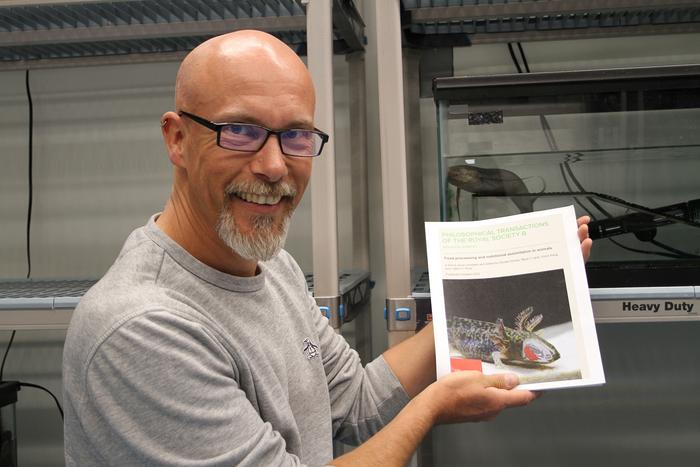Oct. 26, 2023

Credit: Brooke Coupal/UMass Lowell
Oct. 26, 2023
Media contacts:
Emily Gowdey-Backus, director of media relations, [email protected]
Nancy Cicco, assistant director of media relations, [email protected]
UMass Lowell’s Nicolai Konow wants to bridge the gap between research on food processing and nutrient absorption.
“There is a divide between biomechanists, who study chewing and food transport, and physiologists, who examine what actually happens to food in the gastrointestinal tract,” said the assistant professor of biological sciences.
To help link the two fields, Konow edited and contributed to a special edition of Philosophical Transactions of the Royal Society, the world’s longest-running scientific journal. The issue, titled “Food processing and nutritional assimilation in animals,” includes 18 research papers that examine how animals, ranging from ants and sharks to monkeys, eat and digest food.
“This special issue is a call to arms for physiologists and biomechanists to start working together to get a more interdisciplinary angle on the effects of food processing on nutritional assimilation,” says Konow, a biomechanics expert. “There’s a crucial gap in our understanding of the journey of food.”
UMass Lowell alumnus and biological sciences teaching assistant Brian Richard worked with Konow to co-author a paper for the issue that establishes that all animal classes, such as mammals and amphibians, contain members that chew their food. Richard conducted research on rhythmic chewing for the publication while he was an undergraduate student at the university.
“It was very exciting to take part in research while an undergraduate, because it helped with my career development,” said Richard, whose goal is to become a professor, combining his passions for research and teaching. “Having this paper published made me feel like I’m a legit scientist now.”
Konow served as the co-author of two subsequent papers, one of which dispelled earlier studies that stated salamanders do not chew.
“Researchers back in the day didn’t have the technology that we have now,” says Konow, who used an X-ray video camera to show that salamanders chew. “Our research on salamanders substantiates the claim made in the previous paper (co-authored by Richard) that chewing is a general trait across the vertebrate tree of life.”
Konow’s other paper used salamanders as a model to understand feeding constraints among animals that transitioned from water to land more than 350 million years ago.
“Salamanders are a really powerful tool for understanding that critical transformation in evolutionary history,” he said.
Additional papers in the special issue, produced by dozens of researchers from around the world, touched upon diverse topics such as the amount of energy it takes for primates to feed, the effect of climate change on nutritional assimilation in marsupials and how ants generate bite force.
“It’s been a great honor to compile this issue,” Konow said.




